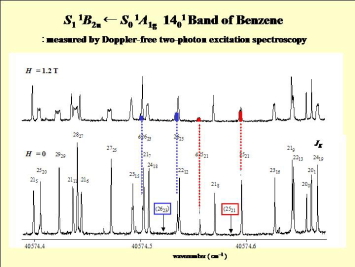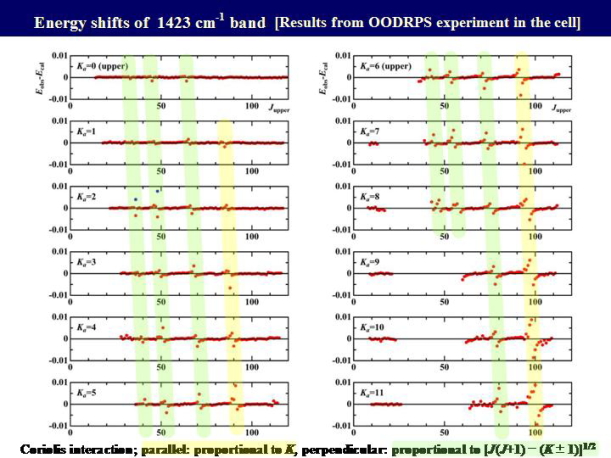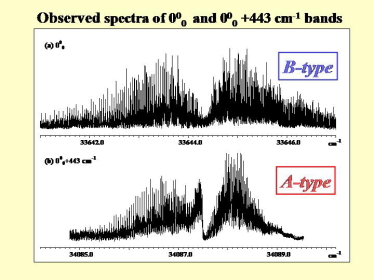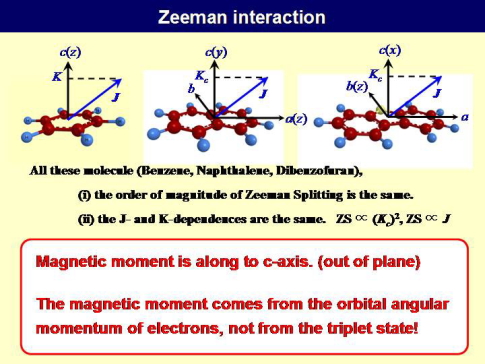I. DOPPLER-FREE TWO-PHOTON EXCITATION SPECTOSCOPY OF BENZENE
Doppler-free high-resolution spectroscopic technique is powerful tool for studying the structure and dynamics of excited polyatomic molecules in detail and unambiguously. Single-mode auto-scan laser systems which work in UV-Visible-NearIR region, the absolute wavenumber measurement system, and several Doppler-free high-resolution spectroscopic measurement systems have been constructed to investigate the excited molecules. High-resolution and high-accuracy of the spectral lines enable to observe rotational resolved electronic transition and to find out the excited state dynamics through the fairly deviation of the spectral position, intensity anomaly and the spectral linewidth. High-resolution laser spectroscopy is very useful to accurately study the molecular structure and dynamical processes in the electronic excited such as internal conversion (IC), intersystem crossing (ISC), and intramolecular vibrational redistribution (IVR). Benzene is a prototype aromatic molecule, and its dynamics in excited states have been studied extensively. Electronic relaxation from the
S
1 state can occur via three pathways: radiative transition
to the
S
0 state, nonradiative transition to isoenergetic levels
of vibrationally highly excited levels of the
S
0 state (IC), and the one of a triplet state (ISC).
The fluorescence quantum yield of the
S
1
state of an isolated benzene was observed to be small, and nonradiative decays
excited to low vibrational levels of the state were attributed to ISC.
Extremely high-resolution can be achieved by Doppler-free two-photon excitation
spectroscopy, and Zeeman spectra combined with high-resolution spectroscopies
are available to identify the coupling between singlet and triplet states.
|
 |
|
Figure 1.
Doppler-free two-photon excitation spectra of benzene at the magnetic field
H = 1.2 T (upper trace) and H = 0 T (lower trace). Assignments of the Q(K)Q(J) lines are indicated
as JK. Remarkable Zeeman splittings (broadenings) are observed for K=J lines. The blue and red lines shows the perturbed and perterbing levels for 2521 and 2623, respectively. Arrows are indicated the calculated (unperturbed) line positions.
|
|
 |
|
Figure 2.
(left) K-dependence of the observed Zeeman splittings of the Q(K)Q(40) lines at H=1.2T.
(right) J-dependence of the observed Zeeman splittings of the Q(K=J)Q(J) lines at H=1.2T.
|
II. DOPPLER-FREE POLARIZATION LABELING SPECTROSCOPY OF NAPHTHALENE
The level density of the rovibronic states of polyatomic molecule makes
difficult to assign the rotational resolved high-resolution spectrum. Optical-optical
double resonance (OODR) technique is very useful to simplify and assign
for such a complicated spectrum. Doppler-free polarization labeling (DFPL)
spectroscopy is a very sensitive technique, and it is easily accessible
Doppler-free OODR polarization labeling (DFOOPL) spectroscopy which is
a powerful tool for the unambiguous assignment for the complicated spectrum
even for the perturbed line. Naphthalene is a prototype aromatic molecule
next to benzene, and a number of studies have been reported on the electronically
excited states and radiationless transitions. The linewidth of the several
vibronic bands of the S
1←S
0
transition in a supersonic jet was reported to increase as the vibrational
energy in the S
1 state increases, and this line broadening was
assigned to intramolecular vibrational redistribution (IVR). High resolution
spectroscopic techniques are useful to observe such line broadening for resolved
single rotational lines. DFPL and DFOOPL spectroscopies are applied to measure
the high resolution spectra and confirm the unambiguous rotational assignment
for the interacting region.
|
 |
|
Figure 3.
The difference between the observed transition energy
Eobs and
the energy Ecal
calculated from the obtained molecular constants is plotted for the rPKa(J)
line (Ka=0-9).
|
III. HIGH RESOLUTION SPECTROSCOPY OF DIBENZOFURAN
Toxic dioxins are serious environmental problems. The three prototype molecules are dibenzo-
p-dioxin, dibenzofuran, and
biphenyl, and their chlorinated and brominated compounds are highly toxic. It
is great important to investigate the molecular structure and the excited state
dynamics. High-resolution fluorescence excitation spectrum of dibenzo-p-dioxin in
a collimated molecular beam has been studied and found that this molecule is
bent out-of-plane and predissociating in the
S
11B
1u state.
This spectroscopic method
also applied to dibenzofuran molecule, and fully rotational resolved
high-resolution spectrum has been observed for the
S
1 ←
S
0 transition.
|
 |
|
Figure 4.
Ultrahigh-resolution fluorescence excitation spectra of the
a) 000 and b) 000 + 443cm-1
bands of the S1 ← S0 transition of dibenzofuran
in a collimated molecular beam.
|
For these molecules, benzene, naphthalene, dibenzofuran, the Zeeman splittings
were observed !

![]()
![]()





![]()